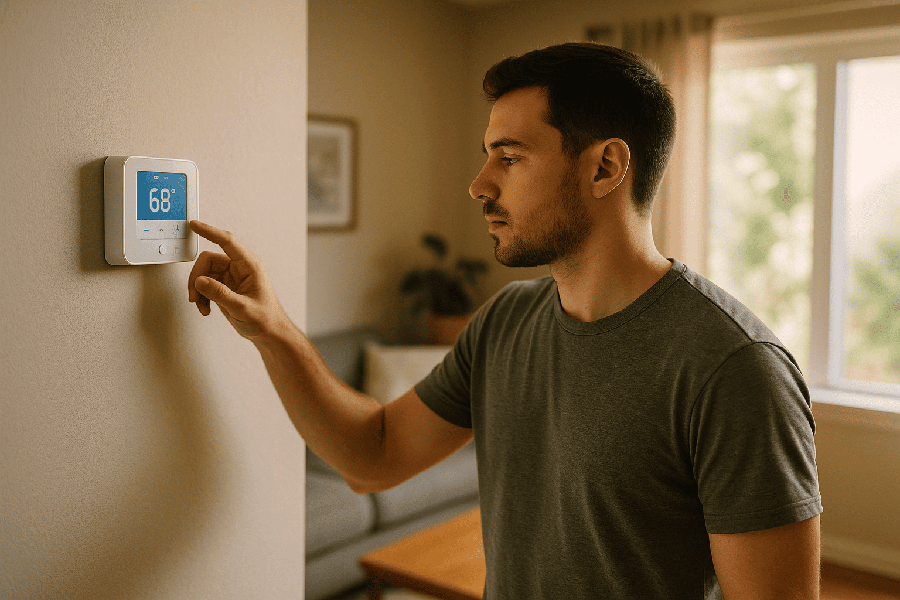Quick Quiz: What’s Your Power Bill Saving Style?
Answer step by step. Your result will appear at the end.
Every month, millions of households open their power bills and feel the same frustration: the numbers always seem higher than expected. Electricity is one of the largest recurring expenses, and unlike rent or mortgage payments, it fluctuates depending on usage, season, and efficiency. Yet many families treat their bill as a fixed cost, when in reality it is one of the most flexible parts of the budget. Learning how to save money on power bill is less about sacrifice and more about recognizing inefficiencies that silently drain your wallet.
The good news is that cutting electricity costs does not require radical lifestyle changes. Instead, it comes from small, strategic adjustments - switching to efficient bulbs, running appliances wisely, sealing leaks, and taking advantage of rebates or programs already available. Each of these actions may look minor, but together they create meaningful monthly savings. This article takes a professional approach, breaking down where most energy is wasted, outlining practical strategies that deliver real dollar amounts, and sharing case studies of families who turned high bills into manageable expenses. With clear steps and proven tools, you will see how simple it is to take control and finally reduce your power costs.
Listen to the article - it is faster than reading!
Where Most Households Waste Energy?
Most households believe their power bills are driven by necessities, but in reality, much of the expense comes from wasted energy. One of the most common sources is heating and cooling inefficiency. Drafty windows, poorly insulated walls, and thermostats left running at the same temperature all day lead to unnecessary consumption. Even a difference of a few degrees can add dozens of dollars to monthly costs. Many families assume comfort requires constant climate control, but smarter management would maintain the same comfort with far less waste.
Lighting is another underestimated factor. Incandescent bulbs still found in many homes use several times more electricity than modern LEDs. A household with ten older bulbs can spend $10-15 more every month than one with efficient replacements. Electronics and appliances also play a role through phantom load. Devices like televisions, gaming consoles, and chargers draw electricity even when turned off, silently adding up to 10 percent of the monthly bill. This hidden usage is often ignored because it is invisible on a daily basis, yet it is constant and costly.
Appliance maintenance is another overlooked area. Dirty refrigerator coils, clogged dryer vents, or poorly maintained HVAC filters reduce efficiency and increase electricity demand. Refrigerators that are too cold or freezers set below optimal levels consume more energy than necessary. Households often set them excessively low “just to be safe,” without realizing the financial impact.
Finally, behavior patterns themselves are a form of waste. Running dishwashers half full, doing laundry in hot water for all loads, or keeping lights on in empty rooms are daily habits that gradually inflate power bills. None of these actions feel large on their own, but together they can raise expenses by $50-$100 each month.
Recognizing where these inefficiencies occur is the foundation for real change. With targeted adjustments, every household can reduce waste without lowering their quality of life.
We are recommend
Appliance Power Usage Tracker
Do you want to understand what your powewr bill consists of?? Built for practical households, the Appliance Power Usage Tracker translates appliance choices into monthly kWh and dollars with transparent math. The Results table ranks costs line by line and surfaces expert actions - set water heaters to 120°F, enable auto-sleep on computers, batch laundry with high-spin, and cook efficiently with lids or a microwave for small portions. Add any custom device in seconds. Revisit after two weeks to confirm savings.
How to Save Money on Your Power Bill? Practical Strategies
Cutting electricity costs is not about giving up comfort - it is about removing inefficiencies that inflate monthly bills. Households often underestimate how much money can be saved through small, consistent adjustments. The most effective methods do not require expensive renovations but instead focus on smarter usage, regular maintenance, and taking advantage of natural resources. Each step creates incremental savings, and when combined, they free up a significant portion of the household budget.
The following strategies are built on practical experience and tested results. They are simple to implement, suitable for both renters and homeowners, and require little upfront investment. More importantly, each method comes with a clear explanation of how it works, why it is effective, and how much money it realistically saves per month. By applying just two or three of these approaches, families often reduce their power bills by $50-$120 monthly. Applied together, they provide lasting relief from rising energy costs.
Replace Old Light Bulbs with LED Bulbs
(Average savings: $10-$20 per month)
Lighting may seem like a small part of your bill, but inefficient bulbs add up quickly. Traditional incandescent bulbs convert most of the electricity they use into heat rather than light, wasting energy and money. In contrast, LED bulbs use about 75% less electricity and last up to 25 times longer. A household that replaces ten frequently used incandescent bulbs with LEDs can expect immediate savings that show up on the next bill.
Why this works
- Lower energy use: Each LED consumes just a fraction of the power of an incandescent bulb.
- Long lifespan: LEDs last for years, reducing replacement costs.
- Cooler operation: Less wasted heat means reduced demand on air conditioning during hot months.
Practical examples
- Swapping out five 60-watt bulbs for 10-watt LEDs saves around 250 watts whenever those lights are on. Over a month, this equals 30-40 kWh, cutting $5-$8.
- Expanding the replacement to 15 bulbs doubles the savings, especially in homes where lights remain on for long hours.
- Many utilities also offer rebates for LED purchases, lowering upfront costs and increasing net savings.
Overall, replacing bulbs is one of the easiest entry points for reducing energy expenses. The average household saves $10-$20 per month, with no sacrifice in lighting quality and the added benefit of fewer trips to buy replacements. This is the kind of low-cost, high-impact adjustment that forms the foundation of long-term energy savings.
Unplug Appliances and Electronics When Not in Use
(Average savings: $15-$30 per month)
One of the most overlooked sources of wasted electricity is phantom load - energy consumed by appliances and electronics even when they are switched off. Televisions, gaming consoles, computers, coffee makers, and phone chargers all draw small amounts of power while idle. When multiplied across an entire household, this hidden usage can add up to 5-10% of a monthly bill. The problem is that phantom load is invisible: devices do not appear “on,” yet the meter continues running.
Why this works
- Constant drain prevention: Cutting off standby power stops energy waste 24/7.
- No lifestyle change required: Devices perform the same when plugged back in, so comfort and convenience remain unchanged.
- Cumulative savings: Even small reductions across multiple appliances combine into noticeable monthly results.
Practical examples
- A cable box or DVR can consume 20-30 watts continuously. Left plugged in all month, that single device costs $2-3.
- Chargers left in outlets, even without phones attached, draw 1-2 watts, equating to $1 per month per charger. Multiply this across several outlets, and the cost rises quickly.
-
A household that unplugs entertainment systems, kitchen appliances, and chargers when not in use can eliminate 50-100 kWh per month of unnecessary consumption.
Smart power strips make the process easier. They automatically cut power to idle devices and restore it when needed. This reduces the effort of constantly unplugging and replugging while ensuring savings continue in the background. Many strips cost under $20 and pay for themselves within a few months.
The impact is significant: households that actively manage phantom load save $15-$30 per month on electricity. While the savings may not come from a single large device, the combined effect of dozens of small appliances running silently in the background is substantial. By reclaiming this wasted power, you reduce costs without changing habits - just by making idle devices truly “off.”
Lower Your Thermostat a Few Degrees
(Average savings: $20-$40 per month)
Heating and cooling account for nearly half of the average household’s electricity consumption, making the thermostat one of the most powerful tools for saving money. Many families set their systems at a constant “comfortable” temperature year-round, unaware that even a small adjustment can translate into meaningful reductions on the power bill. Lowering the thermostat by just 2-3°F in winter or raising it by the same margin in summer can reduce heating and cooling costs by 5-10%. Importantly, these small changes are hardly noticeable in daily life but create measurable financial relief.
Why this works
- Direct impact: Heating and cooling are the largest contributors to power usage, so any reduction has a multiplier effect.
- Effortless adjustment: A one-time change of a few degrees creates ongoing savings with no extra effort.
- Technology support: Smart thermostats automate adjustments, optimizing energy use when you are asleep or away.
Practical examples
- A home with a $200 monthly cooling bill in summer can cut $15-20 just by raising the thermostat 2°F during peak hours.
- In winter, lowering the temperature slightly at night and using blankets saves another $10-15 monthly.
- A programmable thermostat that adjusts automatically when no one is home adds consistency and raises savings by $10-15.
Many households also benefit from zoning - only heating or cooling the rooms they use most frequently. Closing vents in unused rooms and using ceiling fans for circulation helps maintain comfort without increasing system strain. Regular HVAC maintenance, such as changing filters, supports efficiency and prevents energy waste.
Altogether, households applying these adjustments reliably save $20-$40 per month. Over a year, that amounts to $240-$480 - money that can be redirected into savings, debt repayment, or other necessities. Thermostat control is considered one of the most effective and least disruptive strategies for lowering power bills.
Run Major Appliances Only with Full Loads During Off-Peak Hours
(Average savings: $15-$35 per month)
Large household appliances - washing machines, dryers, and dishwashers - are some of the biggest electricity consumers. The way they are used often determines whether your power bill remains reasonable or climbs unnecessarily high. Running these appliances half full doubles the number of cycles without any added benefit, while operating them during peak hours exposes households to higher electricity rates. Many utility companies now implement time-of-use pricing, which charges more in the late afternoon and early evening but offers lower rates at night or early morning. Aligning usage with these cheaper periods creates an immediate financial advantage.
Why this works
- Efficient cycles: Full loads reduce the number of times energy-hungry appliances need to run.
- Lower pricing: Off-peak electricity rates are 20-40% cheaper than peak rates in many regions.
- Dual savings: Combining full loads with off-peak timing maximizes efficiency and cost control.
Practical examples
- A dishwasher consumes about 1.5 kWh per cycle. Running it half-full twice instead of once doubles electricity and water use, adding $5-10 monthly.
- Washing clothes in full loads during off-peak hours reduces energy usage and also cuts water heating costs. This can lower the bill by $10-15.
- Families that shift laundry and dishwashing to late evening often report savings of $15-20 per month on electricity alone.
Many modern appliances include delay-start functions, making it easy to schedule cycles overnight. Pairing this with cold-water laundry and energy-saving settings increases efficiency further. For households with larger families, the difference between scattered half-loads and consolidated full loads translates to dozens of extra dollars saved every month.
Overall, the combination of running full loads and taking advantage of off-peak pricing can save $15-$35 per month. It requires no financial investment, only a change in routine, making it one of the simplest and most accessible strategies for cutting power costs.
Vacuum the Coils Behind Your Refrigerator Regularly
(Average savings: $5-$15 per month)
Refrigerators run 24 hours a day, making them one of the most energy-hungry appliances in any home. What many households don’t realize is that dust and debris collecting on the condenser coils behind or beneath the fridge force the compressor to work harder, using more electricity to keep food cold. Over time, this buildup reduces efficiency by 20-30%, adding unnecessary dollars to every monthly power bill. Regular maintenance - simply vacuuming or brushing the coils - restores performance and ensures the appliance consumes only the electricity it actually needs.
Why this works
- Improved airflow: Clean coils release heat efficiently, reducing compressor workload.
- Lower energy consumption: A well-maintained fridge uses 5-15% less electricity.
- Longer lifespan: Prevents the compressor from overheating and extends appliance durability.
Practical examples
- A typical refrigerator consumes 150-200 kWh per month. With dirty coils, usage can climb to 220 kWh or more, costing an additional $5-10 depending on local rates.
- Cleaning coils every six months can prevent this spike and save $60-120 annually.
- Combined with proper fridge settings (35-37°F), coil maintenance ensures food stays fresh without overcooling and without inflating electricity costs.
The process takes less than 20 minutes and requires no professional help - just a vacuum with a brush attachment or a coil-cleaning brush. Homeowners who adopt this habit often notice the fridge running more quietly and cycling less frequently, both signs of restored efficiency.
Altogether, keeping refrigerator coils clean reduces electricity waste and saves $5-$15 per month. Though the numbers may seem small, this simple task delivers ongoing returns year after year. When combined with other energy-saving strategies, coil maintenance plays a vital role in lowering total power consumption.
Set Your Fridge and Freezer to Optimal Temperatures
(Average savings: $5-$10 per month)
Many households unknowingly waste electricity by setting refrigerators and freezers colder than necessary. While it may feel “safer” to keep appliances running at the lowest temperatures, doing so forces the compressor to work harder and longer, driving up energy consumption without improving food safety. The U.S. Department of Energy recommends keeping the refrigerator between 35-37°F and the freezer at about 0°F (-0.4°F for precision). Within this range, food remains fresh and frozen goods are preserved, but unnecessary power use is avoided.
Why this works
- Efficiency balance: Optimal temperatures prevent overcooling while maintaining food safety.
- Reduced compressor cycles: Less strain lowers both energy consumption and appliance wear.
- Immediate savings: Adjusting a thermostat dial is free and results appear on the very next bill.
Practical examples
- Lowering a fridge from 33°F to 37°F cuts compressor run time by up to 25%, saving $4-7 monthly.
- A freezer kept at -5°F instead of 0°F uses about 5-10% more energy. Adjusting it upward can save another $2-3 per month.
- Combined, these changes prevent 50-70 kWh of waste annually, translating to $60-100 in yearly savings.
This strategy requires no equipment, investment, or special skills. A simple thermometer placed inside your fridge or freezer helps confirm settings are within the recommended range. It is also advisable not to overcrowd shelves, since blocked air circulation reduces cooling efficiency.
On average, proper temperature management saves $5-$10 per month. Though modest compared to larger upgrades, it is a quick, no-cost action that guarantees both efficiency and extended appliance life. In combination with regular coil cleaning, it ensures your refrigerator operates at peak performance without inflating your power bill.
Use the Sun Wisely
(Average savings: $10-$25 per month)
Natural sunlight is one of the most underutilized tools for managing home energy costs. In colder seasons, the sun provides free heat during the day, reducing the need for electric heaters or HVAC systems. Opening curtains or blinds on south-facing windows allows sunlight to warm rooms naturally, while closing them at night prevents the accumulated heat from escaping. In summer, the opposite applies: drawing blinds or using reflective curtains blocks unwanted heat, easing the burden on air conditioning. These simple practices can reduce heating and cooling demands significantly without spending a dollar.
Why this works
- Free heating: Sunlight adds warmth to living spaces during the day.
- Thermal regulation: Closing curtains at night reduces heat loss by up to 10%.
- Cooling support: In hot weather, blocking sunlight lowers room temperatures naturally.
Practical examples
- A household that lowers heating use by one hour per day in winter saves about $8-12 per month.
- Using blackout curtains during summer afternoons can reduce AC demand by 5-10%, cutting another $5-10 monthly.
- Strategic use of curtains can save 100-200 kWh annually, equal to $120-150 over several years.
The best part is accessibility: every household has windows, and adjustments cost nothing. For enhanced results, thermal curtains or window films can be added at modest prices, multiplying savings while improving comfort.
On average, households that consistently use the sun wisely save $10-$25 per month. This approach requires no technology, no major upgrades, and no reduction in comfort - only awareness and consistency. Combined with other strategies, it makes a measurable contribution to lowering your power bill.
Seal Any Air Leaks Around Doors and Windows
(Average savings: $20-$45 per month)
Air leaks are one of the biggest hidden reasons why households overspend on electricity. Drafts around doors, windows, and vents allow conditioned air - whether heated in winter or cooled in summer - to escape. As a result, HVAC systems work harder to maintain the desired temperature, consuming far more energy than necessary. Even small gaps can cause substantial losses over time. Sealing these leaks with weatherstripping, caulk, or draft stoppers is a low-cost solution that delivers immediate and noticeable savings.
Why this works
- Energy preservation: Prevents expensive heated or cooled air from escaping.
- Reduced strain on HVAC: Less runtime lowers both electricity use and maintenance needs.
- Year-round efficiency: Works in every season, keeping the home consistently comfortable.
Practical examples
- A typical home loses 20-30% of heating and cooling energy through leaks. Sealing them can cut monthly bills by $20-45.
- Installing $10 worth of weatherstripping around a drafty door saves $5-10 per month in winter alone.
- Caulking gaps around window frames reduces AC demand during summer, saving another $10-15 monthly.
These improvements require minimal effort and tools. In most cases, they can be completed in a single afternoon, with results visible on the next billing cycle. For renters, removable draft stoppers or window-sealing kits provide the same benefits without permanent alterations.
Households that address air leaks report year-round improvements in both comfort and cost. With average savings of $20-$45 per month, sealing drafts stands out as one of the most efficient and cost-effective strategies for lowering power bills long term.
Checklist: Quick Wins to Save Money
Lowering your power bill does not always require expensive upgrades or complicated strategies. In fact, some of the most effective savings come from simple actions you can take immediately. These quick wins are practical, low-cost, and designed to show results on your very next bill. The goal is to build momentum - once you see the first dollars saved, it becomes easier to stay consistent and adopt bigger strategies later.
Each of these tips is doable immediately and backed by average savings estimates from recent energy-saving research and practical guides. This checklist can be copied and applied today. Even completing just three items can lower your bill by $40-$60 each month, creating immediate breathing room in your budget.
Case Snapshots: Real Families, Real Savings
Common Myths That Keep Bills High
One of the main reasons households struggle to lower their power bills is the persistence of misleading advice. Energy-saving myths are passed down from neighbors, friends, or outdated articles and often sound logical, but in reality, they either produce minimal savings or even increase costs. Believing in these misconceptions keeps families focused on the wrong actions while ignoring strategies that make a real difference.
By exposing these myths and replacing them with facts, you can redirect your efforts toward practices that genuinely reduce expenses.
The following six myths illustrate how misinformation inflates bills and what the evidence-based truth looks like.
- Myth 1: “Turning off lights is enough to cut your bill significantly.”
Many people think that switching lights off when leaving a room is the ultimate energy saver. While it is a good habit, it only addresses a small fraction of total electricity
use. Lighting usually accounts for about 10% of a household’s bill, so even perfect discipline saves only a few dollars. The real issue is when people stop at this step and
believe they are doing enough, leaving heating, cooling, and appliances untouched.
Fact: Real savings come from combining efficient lighting with
system-level strategies. Replacing incandescent bulbs with LEDs reduces consumption by up to 75%, saving $10-$15 per month. However, far larger savings come from thermostat
adjustments, insulation, and appliance efficiency, which can reduce bills by $50-$100 monthly. Lights matter, but focusing only on them misses the bigger picture.
- Myth 2: “Lowering the thermostat drastically will save more money.”
Households sometimes set their thermostat 10-15°F lower in winter or much higher in summer, believing extreme adjustments create maximum savings. The result is discomfort,
system strain, and often minimal reduction in costs because the HVAC unit must work harder to stabilize the temperature afterward. Families end up abandoning the strategy because
it feels unsustainable.
Fact: Moderate adjustments are the key. Lowering or raising the thermostat by just 2-3°F reduces heating and cooling bills by
5-10%, saving $20-$40 per month. A smart thermostat optimizes this further, automatically adjusting while you sleep or are away. The effect is sustainable and comfortable,
proving that steady, small changes are more effective than drastic moves.
- Myth 3: “Unplugging devices isn’t worth the effort.”
It is common to hear that phantom load - the electricity used by idle electronics - is insignificant. Because the individual savings per device are small, many households ignore
this habit. But when dozens of devices are constantly plugged in, the waste becomes substantial. Cable boxes, gaming consoles, and chargers quietly draw power all month long.
Fact:
Phantom load can account for 5-10% of your total bill. A single DVR can waste $3-5 monthly, while idle chargers and consoles add another $10-15. Smart power strips or simply
unplugging devices can save $15-$30 per month without changing how you use them. The effort pays off quickly, especially in tech-heavy households.
- Myth 4: “New appliances don’t pay for themselves.”
Many people delay replacing old refrigerators, washers, or dryers, assuming the upfront cost outweighs the savings. They continue to run inefficient machines for years, unaware
that the additional monthly consumption could cover the cost of an upgrade over time.
Fact: Energy Star-certified appliances use 10-30% less electricity and
water. A new refrigerator can save $10-15 per month, while a high-efficiency washer reduces water heating and electricity by $5-10. Over a decade, the lifetime savings easily
exceed the purchase price. Add rebates and incentives from utility companies, and the return on investment comes even faster.
- Myth 5: “Small daily habits don’t matter.”
Some households believe that actions like running full laundry loads, shortening showers, or adjusting curtains are too minor to influence bills. Since each habit saves only a
few dollars, they seem unimportant in isolation.
Fact: Cumulative savings are powerful. Running appliances efficiently, reducing hot water use, and using
natural light together can cut $30-$50 monthly. Over a year, that’s $400-$600. The key is consistency - habits multiply when practiced daily. Small steps stack up into
major results.
- Myth 6: “Renters can’t do anything to lower their power bills.”
Tenants often feel powerless because they cannot upgrade insulation or replace appliances in their rental units. They assume they must accept high bills as part of renting.
Fact:
Renters have plenty of effective options. LED bulbs, smart power strips, thermal curtains, draft stoppers, and efficient usage habits can save $30-$60 monthly without altering
the property. Many utility rebates are also available directly to tenants. Ownership isn’t required to cut bills - awareness and small actions are enough to make a real
difference.
Tools & Resources That Really Help You to Save Money on Power Bill
Saving on your power bill is not just about habits - it also depends on having the right tools and support systems. Many households fail to take advantage of free or low-cost resources that identify inefficiencies and provide direct financial relief. Utility companies, government programs, and technology solutions all offer opportunities to cut monthly bills without lowering comfort. The challenge is knowing which tools deliver real value and which are unnecessary. By focusing on trusted programs and proven devices, you can confidently invest your time and money. The following resources have been tested by millions of users and consistently recommended by energy professionals. They combine accessibility, effectiveness, and measurable savings, making them essential for anyone serious about lowering their electricity costs.
| Tool/Resource | How It Helps & Why It Works |
| Home Energy Audits | Many utility companies provide free or low-cost home energy audits. Specialists identify where energy is wasted - drafts, poor insulation, or inefficient appliances - and suggest targeted improvements. The benefit is clarity: you know exactly what to fix rather than guessing. Households that follow audit recommendations often save $15-$50 per month. |
| Smart Thermostats (Nest, Ecobee) | Smart thermostats optimize heating and cooling by learning your schedule and adjusting automatically. They reduce waste when nobody is home and maintain comfort efficiently. Typical savings reach $20-$35 monthly. Rebates from utilities lower the upfront cost, making this one of the fastest-returning upgrades. |
| Energy Usage Monitoring Apps (Smappee, Neurio, Emporia Energy) | These apps provide real-time data on household electricity use, showing which appliances consume the most. This transparency helps identify hidden drains like phantom load or inefficient devices. Families using such apps save $15-$30 monthly by cutting wasteful habits. |
| Weatherstripping and Sealing Kits | Simple, inexpensive kits block drafts around doors and windows. By keeping conditioned air inside, they reduce HVAC runtime and lower bills by $10-$20 monthly. Easy to install, renter-friendly, and immediately effective. |
| Time-of-Use Energy Plans | Some utilities charge lower rates at night or early morning. Running laundry or dishwashers during off-peak hours can save $15-$25 monthly. This approach requires no investment, only a shift in routine. |
| Portable Electric Heaters | When heating a single room, using a portable electric heater may be cheaper than central heating. The key is careful use - only in occupied rooms, with thermostats lowered elsewhere. Potential savings are $10-$20 monthly in winter. |
| Energy-Efficient Appliances & LED Lighting | Upgrading to Energy Star appliances and LED bulbs reduces electricity use by 10-30%. A fridge swap alone saves $10-15 monthly, while LEDs add another $10. Over time, savings outweigh the purchase cost. |
| Utility Company Rebates & Incentives | Many providers offer rebates on efficient appliances, smart thermostats, or even solar panels. Some also give free energy-saving kits. Programs typically reduce bills by $10-$30 monthly while cutting upgrade costs. |
| Government Energy Saver Guides | Federal and local governments publish practical guides tailored to regions. They include proven strategies, seasonal tips, and calculators to estimate potential savings. Trusted and free, these guides help households adopt effective habits. |
| AI Tools for Energy Insights (e.g., Microsoft Copilot) | AI-powered assistants explain appliance energy use and suggest optimizations based on habits. They turn raw consumption data into actionable steps. For tech-savvy households, this tool offers personalized insights and savings of $10-$20 monthly. |
FAQ: How to Save on Power Bills
Q1. What are the fastest ways to reduce my power bill this month without sacrificing comfort?
Start where impact is highest: heating/cooling, lighting, and “phantom” load. Set your thermostat 2-3°F closer to outdoor temps and use a schedule while you sleep or are away; that alone trims 5-10% of HVAC use. Replace five high-use bulbs with LEDs and add two smart power strips to entertainment areas to kill standby draw. Run laundry and dishwashers only with full loads, and shift cycles to off-peak hours if your utility offers time-of-use pricing. Seal one drafty door or window and clean refrigerator coils. If you’re wondering how to save on your power bill, stack these changes the same week and immediately redirect the dollar difference into a “Utilities Savings” sub-account to cement the habit.
Q2. How can I lower electricity costs if I’m not ready to buy new appliances or do major upgrades?
Focus on behavior, scheduling, and maintenance. Use LEDs, unplug idle chargers, and put entertainment gear on smart strips to eliminate standby losses. Wash in cold, air-dry when possible, and run only full loads. Close blinds against summer heat, open them for winter sun, and set ceiling fans to the correct seasonal direction to ease HVAC strain. Vacuum fridge coils and set temperatures to 37°F (fridge) and 0°F (freezer). If you’re asking how to save on power without spending money, align heavy-use tasks (laundry/dishwashing) with off-peak windows, and standardize a weekly “energy reset” checklist: lights off in unused rooms, devices unplugged, thermostats checked, and vents unblocked. These zero-cost habits consistently add up to $30-$60 per month.
Q3. What is a practical 30-day plan - how to save money on my power bill - that I can follow step by step?
Week 1: Audit your habits. Photograph current thermostat settings, list major appliances, and identify five always-on devices; install two smart strips and replace five bulbs with LEDs. Week 2: Scheduling. Move laundry/dishwasher to off-peak, switch to cold-water cycles, and set a nightly “all-off” phone reminder. Week 3: Efficiency tune-up. Clean fridge coils, set 37°F/0°F, change HVAC filters, and seal one drafty window/door with weatherstripping. Week 4: Optimize comfort. Adjust thermostat 2-3°F, use curtains strategically (sun in winter, shade in summer), and set ceiling fans correctly. Track your bill delta in a simple ledger (date, action, kWh, $). Most households see $40-$100 in monthly reductions by day 30, with no loss of comfort - just less waste.
Q4. Are smart thermostats, smart plugs, and home energy monitors actually worth the money?
Yes - when matched to your home and used consistently. A smart thermostat automates the most expensive load (HVAC), applying setback schedules you won’t maintain manually; typical savings land around 5-10% of heating/cooling costs. Smart plugs and advanced strips eliminate standby draw from TVs, consoles, and office gear, cutting 5-10% of total usage in tech-heavy homes. An energy monitor (panel-level) reveals the real hogs - old fridges, space heaters used as primary heat, or forgotten dehumidifiers - so you act on data, not guesses. Look for utility rebates to shrink upfront cost, then set alerts, weekly reports, and automation rules. Payback often arrives within 6-12 months, after which the devices keep producing savings with minimal effort.
Q5. When should I run major appliances to pay less - do time-of-use (TOU) plans really help?
If your provider offers TOU pricing, rates are higher at afternoon/evening peaks and lower late at night or early morning. Shifting laundry and dishwashing to off-peak can reduce cycle costs by 20-40%. Combine that with full loads only, cold-water washes, and eco settings, and the savings compound. Use delay-start buttons to finish cycles before you wake up, and avoid running dryers while AC is fighting heat; the combined load spikes usage. Not on TOU? You still benefit by batching tasks: fewer total cycles, less hot-water demand, and smarter thermostat coordination (pause HVAC boosts while the oven or dryer runs). Track one billing period with and without scheduling to see the dollar impact in your statement.
Q6. I rent - what can I realistically do to lower power costs quickly if I can’t renovate?
Plenty. Swap in LEDs, add removable draft stoppers, use thermal curtains, and put media centers on smart strips. Standardize cold-water laundry and full loads only, and move cycles to off-peak if available. Set the fridge/freezer to 37°F/0°F and clean coils; it’s maintenance, not modification. Use fans for comfort and adjust the thermostat a couple of degrees rather than running AC/heat hard. Talk to your landlord with numbers: propose low-cost weatherstripping or an efficient showerhead and share any utility rebates that offset costs. Keep a simple monthly tracker (kWh and $). For readers searching how to save money on power, renter-friendly fixes reliably deliver $30-$70 in monthly savings without changing the property.
Final Thoughts: Turning Savings Into Stability
Electricity costs feel “fixed” until you break them into habits, schedules, and a few smart tools. The moment you do, the bill becomes a system you can tune. You’ve seen how thermostat discipline, LED lighting, off-peak scheduling, and small maintenance tasks stack into meaningful dollars - often $40-$100 a month - without sacrificing comfort. Treat each action as a repeatable process: set it once, let it run, and capture the savings into a dedicated account labeled “Power Wins.”
Start now: choose one quick win from the checklist, set a same-day reminder to apply it, and log the new bill amount when it arrives. That single step builds momentum, and momentum compounds. For anyone wondering how to save money on power, the answer is consistent execution - small, high-leverage moves that keep paying you back every month. Make the first change today, prove it with your next statement, and then add the next lever. Your lower bill becomes your new baseline - and your budget breathes easier.






